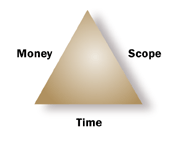Every project balances a “triangle” consisting of time, money, and scope as its characteristics — where you cannot change one without affecting at least one of the others. The main aim of the project manager is to keep the triangle intact and protect it from falling apart.
Time + Money + Scope = Quality
So when a problem arises following steps should be taken,
- First, Locate the problem on the project triangle — Whether the problem is associated with time (schedule), money (budget), or scope
- Second, find out which sides of the triangle can be changed and which are fixed.
- Third, make the necessary alteration required to fix the problem and optimize the project.
- Fourth, finish the project and provide reviews/feedbacks
The project triangle is also referred as ‘iron triangle’ or ‘triple constraints’

Case based analysis on ‘Project Triangle’
In order to achieve the finish date (time), you may be required to spend more in resources (money) so as to finish the work faster or reduce the number of features (scope) so as to reduce the work to do achieve the new deadline.
In order to achieve the project under budget (cost), you may be required to get rid of overtime and finish the project later (time) or reduce the overall features (scope).
In order to achieve the product (scope), you may be required to extend the deadline to make time for the new work (time) or add people to get it done faster (cost).
Note, Quality is the fourth part of the project triangle located at the heart of the triangle, where any change to any side, primarily affects the quality in the end.

For instance, you are ahead of scheduled time in the project, in this case so you might be able to replace cut features (scope) or allow more time to the existing tasks. So with this additional time and scope, there is a chance that the outcome might be a better product.
Note, there is s no universal standard for quality in a project. So, for any given project, the quality required needs to be defined within the project itself. For example, in a company, keeping a project on budget is the most important measure of quality wherein for some other company, getting it to market on time is of key concern. Thus the project manager should be clear as to how quality is defined for the company and how quality is defined for a specific project.
What you can’t change
Be careful that in most of the projects, there will be at least one side of the triangle which will be in a fixed place that you cannot change. Maybe the budget is non-negotiable or maybe the product absolutely has to go on sale by a certain date. Or maybe both holds true.
Most of the time, the fixed element of the project is dictated from above the project manager. But sometimes it on the shoulders of the project manager to decide which element is most important to the success of the project.
How to address the problem in the Project Triangle?
In case, the problem occurs on a fixed side, the course of action is often clear. For instance, if you discover that the launch of a software feature will take longer to complete than predicted time and since you have already signed a contract saying you will deliver that feature (scope), in this case you either have to move the finish date out or add resources to finish it on the stipulated time.
In case, the fixed side and the problem side are different, then do not quit. The beauty of the project triangle is that there is always room to make changes. For instance, if your project has to be finished on time but it has grown in scope, in this case you can still adjust the cost by adding resources.
In case, if all three sides of the triangle have some issues, then do not panic. This clearly indicates that the project might be in trouble, since you are aware that project is in trouble then you have a good starting point to reorganize the goals of the project or improve the quality standards for better performance.

